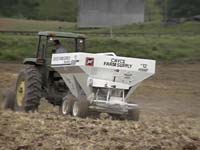High Nitrogen Prices Have Farmers Looking for Savings
High Nitrogen Prices Have Farmers Looking for Savings

With the high cost of nitrogen fertilizer and questions about availability, farmers should consider whether they are using appropriate amounts, and if split applications are a viable option.
Splitting applications between preplanting and side dressing once corn begins growing can lower the total amount of nitrogen needed to achieve maximum yield.
Nitrogen is the main source of fertilizer for corn, and the cost has been adversely affected by escalating natural gas prices. Natural gas makes up the bulk of the cost of producing nitrogen.
A good soil test to determine nitrogen and nitrate levels in soils is not available, therefore the University of Kentucky College of Agriculture uses a method that considers soil type and tillage methods in determining nitrogen needs.
"Our present recommendations are based on long-time research," said Lloyd Murdock, UK Extension soils specialist.
In looking at a curve charting maximum yields and nitrogen input, the most efficient place for a farmer to operate is right below the maximum yield range. That's because the amount of nitrogen needed to move to maximum yield doesn't return the costs, he said.
UK recommendation rates are at the beginning of maximum yield rates shown on the curve. Most farmers operate at maximum yields and even use nitrogen levels beyond that, Murdock said.
If a farmer wants to save money on nitrogen this year, the first thing he needs to consider is where he is operating on this curve. For example, UK's recommendation is for 175 to 200 pounds of nitrogen on moderately well- drained soils where the corn is no-till planted. If a farmer has used 220 pounds on that field in the past, then he has a potential savings from reducing that by at least 20 pounds.
On years of high nitrogen prices, a farmer should probably be closer to the 175 pounds of nitrogen range and therefore the savings would be much greater, Murdock said.
In Kentucky's No.1 corn producing county, farmers likely will cut back on the amount of nitrogen this year, said Rankin Powell, Union County extension agent for agriculture and natural resources. Farmers applying 200 units of nitrogen may drop to 175, he said.
Good crop years generally don't require excessive nitrogen, Murdock said. Research has shown with proper moisture and sunlight, nitrogen in the soil is more accessible than it is in poorer growing seasons.
Some farmers use yield goals as a guideline in determining nitrogen need, but Murdock said UK does not recommend this. Many times it is not viable economically, he said. However, if a farmer did want to do that, in well drained soils a rule of thumb is 1 pound to 1.1 pounds per bushel, and 1.1 to 1.2 pounds per bushel on poorly drained soils, he said.
That's the method that Union County farmer Randy Hagan will use.
Hagan said the high prices have changed his normal nitrogen use in several ways. In the past, he's generally used 200 pounds of nitrogen per acre across this corn fields, but this year will be looking at the 7-year cropping history in those fields and adjusting the nitrogen needs based on average yields and what he'd like to achieve.
The Waverly farmer said he also is changing some types of nitrogen fertilizer he will use, and is switching his fall applications to spring.
Hagan said he anticipates reducing his nitrogen usage by 10 percent.
"We'll still be using nitrogen, just more conservative in the amount," he said.
Farmers sometimes adjust their nitrogen input in fields where corn is planted after soybeans. While UK does not recognize nitrogen boosts in fields for corn after soybeans, if a farmer has been reducing his nitrogen in that situation he would need to add that back in if his cropping system is going to corn after corn, Murdock said.
Side dressing corn with a nitrogen source on moderately and poorly drained fields can reduce the amount of nitrogen needed by 30 to 35 pounds per acre if two thirds is put on through side dressing.
Some farmers don't like side dressing because it doesn't fit their system, but in conversation tillage it is the best way to apply nitrogen, Murdock said.
Powell said he does not expect farmers to switch to soybeans, a crop that does not require added nitrogen, in order to reduce the costs. The switch will only occur if corn cannot be planted in a timely manner, he said.
Farmers who have access to animal manure and chicken litter can use these as a source of nitrogen.
"It's an outstanding alternative source of nitrogen," Murdock said. "It's a pretty cheap source of nitrogen especially if you need the potassium and phosphorus to go with it."
For more information on fertilizer recommendations and using animal manure as nutrient sources contact your local Extension office and ask for publication AGR-1 and AGR- 146.
